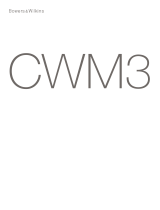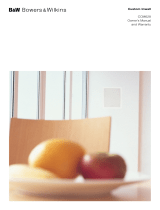
3
ENGLISH
Note: Different acoustic environments might be,
for example, a bare wall and a heavily curtained
window.
Diagram 2 illustrates the general speaker location
guidelines.
Note: The nature of the installation of ceiling
speakers means that it is sometimes impractical
to locate them in the acoustically ideal positions.
In these cases they should be located as close
as is practical to the ideal positions. Your local
Bowers & Wilkins retailer will be able to offer
advice if required.
Note: CCM3 Series drive units create
stray magnetic elds. We recommend that
magnetically sensitive items such as CRT
screens and magnetic cards for example, are
kept at least 0.5m (20 in) from the speaker.
LCD and plasma screens are not affected by
magnetic elds.
1. Unpacking
The CCM3 Series of ceiling mount speakers is
designed to offer easy installation and high quality
audio reproduction for discrete custom install
applications. They are particularly suitable for use in
humid environment such as swimming pools. This
manual describes the installation of CCM3 Series
speakers within conventional stud and sheetrock
(joist and plasterboard) ceilings. It begins by listing
the contents of the CCM3 series carton:
1. Two CCM3 Series speakers
2. Two CCM3 speaker grilles
3. One aperture template
4. Two paint masks
5. Quick Start Guide
6. Warranty information
2. CCM3 Series Basics
CCM3 Series ceiling mount speakers comprise a
bafe carrying the speaker drivers, crossover circuit
and connectors, and a magnetically secured grille.
The bafe is secured in the ceiling aperture by dog-
clamps that swing outwards and tighten.
Note: A square grille is optionally available for
CCM3 Series speakers. Contact your local
Bowers & Wilkins retailer for more information.
CCM3 Series speakers require ceiling aperture
and height clearance dimensions described in the
following table:
Minimum Height
Model Aperture Diameter Clearance
CCM362 204mm (8.0 in) 79mm (3.2 in)
CCM382 253mm (9.9 in) 85mm (3.4 in)
Note: If CCM3 Series speakers are to be installed
in “new build” projects, pre-mount kits and
back boxes are available. Use of pre-mount kits
is described in Section 5. Use of back-boxes
is described in the separate CI300 Back-box
Installation document.
Before installing CCM3 Series speakers you should
ensure that the ceiling locations chosen are free of
obstructions such as pipe work, ducting or wiring
that will interfere with the installation. In existing dry-
wall construction, use a stud-nding tool to help you
map the ceiling construction and a pipe detector to
scan the proposed installation locations.
Diagram 1
Aperture and height clearance
3. Positioning CCM3 Series Speakers
The appropriate position for CCM3 Series speakers
within the listening environment will depend on their
specic application:
General Background Audio Applications:
For applications where single CCM3 Series speakers
are required to operate independently to provide
background audio, they can be located substantially
as installation convenience and architecture dictate.
The only acoustic constraint to bear in mind is that
corner locations will result in signicantly emphasised
low frequencies and should be avoided.
Stereo Audio Applications:
For applications where a pair of CCM3 Series
speakers is to be used for conventional stereo
reproduction, they should be located between 3m
(10 ft) and 5m (16.5ft) apart and a similar distance
in front of the listening area. Try to avoid corner
locations for the speakers and to ensure that
acoustic environment around each speaker is similar.
Note: Different acoustic environments might be,
for example, a bare wall and a heavily curtained
window.
Multi-channel Audio Applications:
For applications where multiple CCM3 Series
speakers are to be used for multi-channel audio-
visual systems, the front and centre speakers should
be located approximately 0.5m (20 in) in front of
the plane of the screen. The centre speaker should
be on the centre line of the screen and the front
speakers each laterally within approximately 0.5m
(20 in) of the sides of the screen. Surround channel
CCM3 Series speakers should be located just
behind and either side of the listening position. Try to
avoid corner locations for any of the speakers and to
ensure that the acoustic environment around each
front and surround speaker is similar.
Diagram 2
Positioning
CCM362
CCM382
3m (10 ft) - 5m (16.5ft)
3m (10 ft) -
5m (16.5ft)
0.5m (20 in)
0.5m (20 in)
0.5m (20 in)
Stereo Audio Applications
Multi-channel Audio Applications
Ø 204mm (8in)
CUTOUT
Ø 253mm (9.9in)
CUTOUT
85mm
(3.4in)
79mm
(3.2in)
0.5m (20in) 0.5m (20in)
0.5m (20in)
3m (10 ft) - 5m (16.5 ft)
3m (10 ft) -
5m (16.5 ft)












